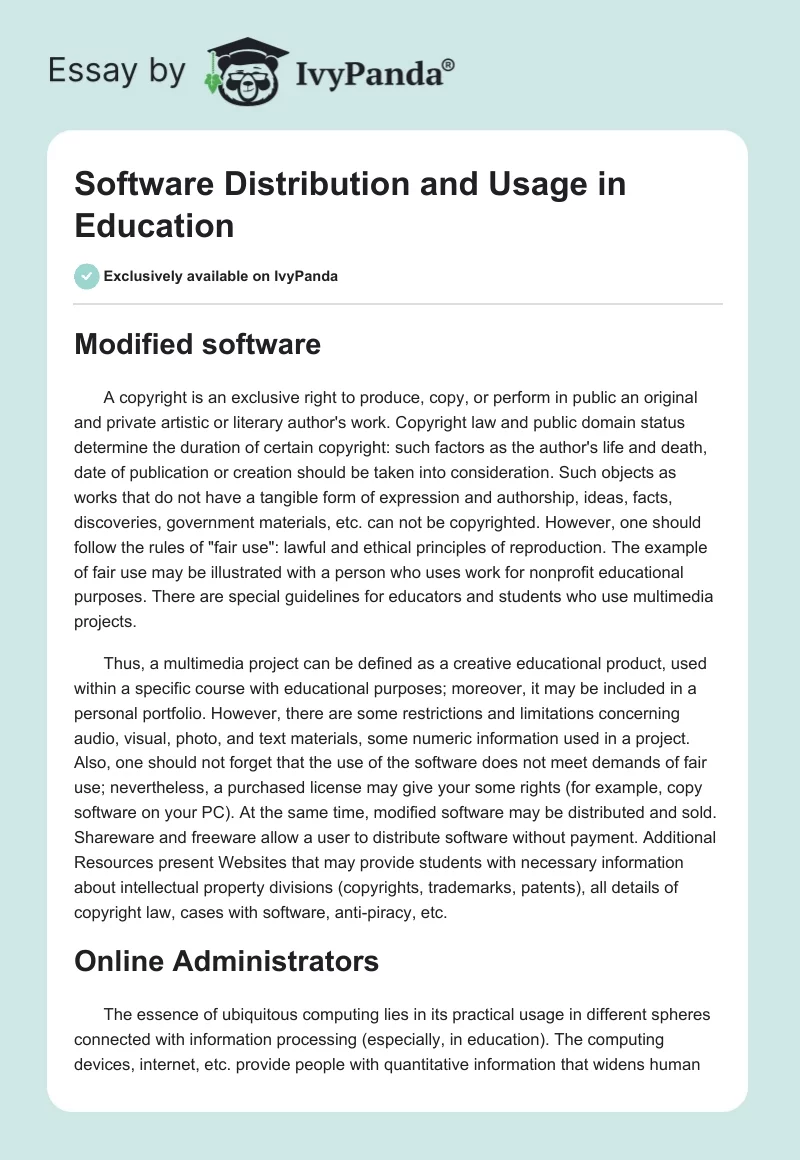Modified software
A copyright is an exclusive right to produce, copy, or perform in public an original and private artistic or literary author’s work. Copyright law and public domain status determine the duration of certain copyright: such factors as the author’s life and death, date of publication or creation should be taken into consideration. Such objects as works that do not have a tangible form of expression and authorship, ideas, facts, discoveries, government materials, etc. can not be copyrighted. However, one should follow the rules of “fair use”: lawful and ethical principles of reproduction. The example of fair use may be illustrated with a person who uses work for nonprofit educational purposes. There are special guidelines for educators and students who use multimedia projects.
Thus, a multimedia project can be defined as a creative educational product, used within a specific course with educational purposes; moreover, it may be included in a personal portfolio. However, there are some restrictions and limitations concerning audio, visual, photo, and text materials, some numeric information used in a project. Also, one should not forget that the use of the software does not meet demands of fair use; nevertheless, a purchased license may give your some rights (for example, copy software on your PC). At the same time, modified software may be distributed and sold. Shareware and freeware allow a user to distribute software without payment. Additional Resources present Websites that may provide students with necessary information about intellectual property divisions (copyrights, trademarks, patents), all details of copyright law, cases with software, anti-piracy, etc.
Online Administrators
The essence of ubiquitous computing lies in its practical usage in different spheres connected with information processing (especially, in education). The computing devices, internet, etc. provide people with quantitative information that widens human knowledge. Ubiquitous computing allows researchers to prove their investigations with evidence.
The modern highly technological world is impossible without computers and the Web. The wide usage of the web determined certain rules of computer ethics. Usually, the term “netiquette” is used to define certain social rules that allow people to interact with each other without any problems. Any user should respect other users, and know that his computer online operations or communications should not harm or humiliate other people. Special online administrators (on forums, games, chat rooms) watch how users follow the principles of netiquette.
The MENSA test
Offers to answer the questions. If one passes, he/she may be considered a genius. There are 33 codified expressions, for example, “24 H in a D” (24 Hours in a Day), “12 M in a Y” (12 Months in a Year), etc. I enjoyed it, but some of them are extremely difficult to decipher. I passed only 17 of 33. Some of the coded expressions make me use sources to be decoded (the Internet informational websites, Google search, books on abbreviations).
Learning style
I learn about technology using all possible learning tools: manuals, textbooks, courses. Mostly, communication with people (asking for help), playing with software, online tutorials, and information is the most helpful tool for me. However, certain tools may provide particular information; thus, my learning style is not the same for all kinds of technology.
Pros and cons of the portfolio
For myself
Pros
- Working and presentation portfolios allow me to present a personal documented learning and professional information in an electronic version (consequently, it can be easily modified, distributed, saturated with web-links that prove my professional achievements) that may influence prospective employers;
- As a portfolio is a reflection process, it gives self-assessment experience that influences my self-esteem and self-confidence.
Cons
- It is impossible to create a good electronic portfolio without certain practice and experience;
- Inadequate self-assessment makes a portfolio misinformative and misleading for a target audience.’
For educators
Pros
- An electronic portfolio contains valuable and useful professional and background information and teaching artifacts (teaching activity reflection) that give a documental presentation of lifelong learning educator’s experience, skills, and achievements;
- A portfolio helps an educator to assess and explore personal professional interests and career options.
Cons
- Presented evidence (in forms of teaching artifacts, for example) may seem insufficient to ensure a potential employer in an educator’s competence;
- If a portfolio does not reflect an educator’s professional development, it will not be successful.
For students
Pros
- An electronic portfolio helps a student to concentrate on his goals, learning abilities and preferences that make him aimed to personal professional future (career-planning process);
- It encourages and stimulates a student to develop more skills and abilities in the future.
Cons
- A student’s electronic portfolio should be saturated with multiple pieces of evidence of his achievements, otherwise, it will not be successful;
- It needs to be constantly updated; if it is not, the portfolio will inadequately present the student’s information.


